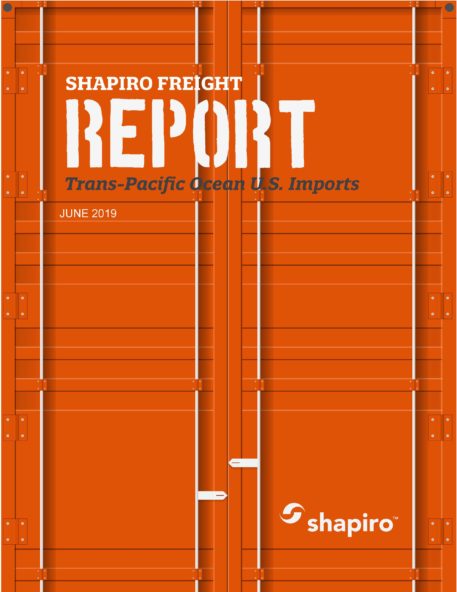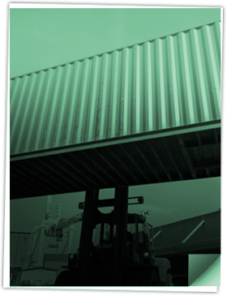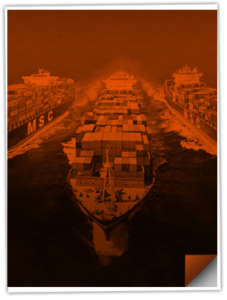Featured Headlines:
Section 301 List 3 Exclusions Are Coming!
Rules of Origin and Substantial Transformation Testing 101
Walmart Leads Retailers in Rebuke of China-U.S. Trade War
The Not So Hot Pursuit of Alternative Sourcing
Chinese Manufacturers and U.S. Shippers Begin Altering Trade Routes on Exports to U.S.
Maersk and Hamburg Sud Expand Latin America-North Europe Service
Worsening Climate Change Disruptions Pose Concern for Global Supply Chains
Update on Vessel Restrictions and Delays at the Panama Canal
Carriers Exercise Caution with Blank Sailings Ahead of Peak Summer Season…For Now
Air Cargo Update, or Should We Say Downdate?
Section 301 List 3 Exclusions Are Coming!
Earlier this month, it was announced that Section 301 List 3 items will be subject to an exclusion process. With the recent increase in List 3 duties from 10% to 25%, importers are now feeling the heat more than ever since the original implementation of List 3 tariffs on September 24, 2018. The third list encompasses over $200 billion worth of goods from China, which is more than double that of List 1 and List 2 combined.
As of May 13th, the United States Trade Representative (USTR) has granted 4 separate rounds of product exclusions for List 1, but has yet to release any for List 2. The List 1 exclusion process had an estimated 5,000 requests submitted, while less than 2,000 exclusions were granted.
Importers who had products that were granted exclusions are able to apply those exclusions to current and previous entries using an additional Chapter 99 HTS number. Applicable importers can also apply for refunds on any duties paid on imports dating back to the implementation date of List 1 – July 6th, 2018. It is important to note that exclusions are not company-specific, but rather product-specific, meaning that any company importing a product that was granted an exclusion can benefit.
While it may take time for the exclusions to be granted, it seems to be worth the wait! If you’ve been affected by Section 301 – List 3, this is the time to begin preparing for the exclusion process.
If you are unsure if you should apply for an exclusion, here are some questions to ask:
- Is China the only country that is able to produce my product?
- Will these additional duties cause severe economic harm to my company and/or my consumer?
- Is my product a strategically important part of Chinese Industrial programs (i.e. ‘Made in China 2025’)?
If you answered ‘no’ to any of these questions – requesting an exclusion may not be beneficial for you…However, if you answered ‘yes’ – then there is a chance your exclusion may be granted!
Be sure to include the supporting documentation to these questions as well as the quantity and values for your last 3 years’-worth of shipments. You’ll also need to be able to provide a detailed description of the product that will provide more information beyond the 8-digit classification.
Looking to get the 311 on 301 product exclusions? Visit our Tariff News page for the latest updates, or contact our compliance experts to discuss your options.
Rules of Origin and Substantial Transformation Testing 101
As the trade war between China and the U.S. intensifies, many companies are considering alternative sourcing, or sourcing from other countries, to alleviate financial concerns and take advantage of more favorable market conditions. As companies look to shift, it’s important to remember that rules of origin are a critically important component when ensuring reasonable care is demonstrated, as is legally required throughout the import process.
What exactly are rules of origin?
Rules of origin are the criteria used to define where a product was made, which helps to identify applicable trade policy implementation measures, such as trade preferences, quotas, anti-dumping and countervailing duties.
Rules of origin requirements legally compel importers to determine the country of origin on any product destined for import to the United States. It’s important to keep in mind that country of origin does not always equal country of export.
Understanding and determining country of origin can be very complex within a globalized supply chain. The complexity in defining the origin of a product tends to arise when 2 or more countries are involved in the production of a single good. One of the most common ways to determine country of origin when a product has components from multiple countries is the substantial transformation test.
According to CBP, “an article that consists in whole or in part of materials from more than one country is a product of the country in which it has been substantially transformed into a new and different article of commerce with a name, character, and use distinct from that one the article or articles from which it was so transformed.”
Here’s a sample substantial transformation test example: Country E manufactures cookies made up of ingredients imported from 4 separate countries: Country A – sugar, Country B – flour, Country C – dairy products and Country D – nuts. In this instance, Country E would be the documented country of origin.
On the flip side, repacking, dilution with water, and similar processes described as “minor” usually do not cause a substantial transformation. Hence, these processes would not denote a substantial transformation and would have no bearing on rules of origin.
Assembly or disassembly may result in a substantial transformation, depending on the nature of the products involved and the complexity of the operations.
Interested in learning more? Check out Brushing Up on CBP Country of Origin Marking Procedures in our May 2019 Shap Talk for a quick review on proper marking and labeling requirements.
Walmart Leads Retailers in Rebuke of China-U.S. Trade War
President Trump has made it clear that he has no intent of harming U.S. consumers with the continued implementation and escalation of Section 301 tariffs on Chinese manufactured goods. However, a multitude of companies, the most vocal of which seems to be Walmart, are convinced that the cost burden of the additional tariffs will fall squarely on the shoulders of U.S. consumers.
With over 26% of Walmart’s products originating from China, the company has faced significant upward pressure on its costs as a result of Section 301 duties. Walmart initially sought to counteract the tariffs by working with its suppliers to reengineer products, lower operational costs and share the burden of any extra costs. However, the recent List 3 tariff increase from 10% to 25% has made it immensely difficult for the retailer to continue to bear the increasing costs without passing them onto consumers.
Speaking to reporters, Walmart CFO Brett Biggs warned that “[i]ncreased tariffs will lead to increased prices we believe for our customers.”
The National Retail Federation has echoed this sentiment as an industry-wide concern, with President Matthew Shay stating that the 25% tariff rate for List 3 (not to mention the potential of List 4) raised costs to such an extent that mitigation strategies used for previous rounds would no longer be viable, leaving cost increases to consumers as the only option.
Don’t miss the boat on Section 301! Our marketing experts can help you evaluate the impact on your supply chain and assist you in weighing sourcing alternatives to reduce your tariffs risk. Reach out to us today!
The Not So Hot Pursuit of Alternative Sourcing
The recent escalation in the ongoing U.S.-China trade war is heating up just in time for summer’s peak, and companies are in hot pursuit of sourcing alternatives!
However, manufacturing and transportation infrastructure in Vietnam, Thailand, Cambodia and other Southeast Asian countries is not as developed or sophisticated as it is in China, which is causing headaches for logistics experts tasked with navigating the minefield of congested/understaffed ports, poor roadways and limited railways when pursuing new production options.
Ultimately, Southeast Asian suppliers are struggling to compete with Chinese factory capacity due to the enormous size of the Chinese workforce, which makes it nearly impossible for U.S. companies to shift all production from China. Despite the lower working wages in many Southeast Asian countries, the slower manufacturing processes, congested cargo terminals and longer transit times are often not enough to offset increased duty rates. Hence, many large importers are electing to ‘stick things out in China’, at least in the short-term.
In the long-term, a plethora of top Chinese manufacturers have already made acquisitions of physical assets throughout Southeast Asia, meaning they are preparing to ramp up production in a competitive way outside of China. Though many assets may be in place, properly outfitting the new factories with the technology and man power required to compete with the efficiency of Chinese factories and to truly recognize an economy of scale is likely still years away.
Take note – it’s not just American companies on red alert. Countries with higher reliance on U.S. trade, such as Japan, have also sought production shifts away from China in an effort to curtail the hefty duty incurred on exports to the U.S.
How can we help? Shapiro has a team of marketing experts on staff that are ready to fully and appropriately discuss meaningful short-term and long-term strategies that will best benefit your supply chain. Please reach out to [email protected] to get started!
Chinese Manufacturers and U.S. Shippers Begin Altering Trade Routes on Exports to U.S.
Nikkei, the primary index for the Tokyo Stock Exchange, reported that Chinese exports to the U.S. decreased by 12%, or $15.2 million, as of the end of Q1 2019 in a year-over-year comparison. Conversely, there was also a noticeable rise in U.S.-bound Chinese exports routed through Vietnam, Taiwan and Mexico. Naturally, companies are combing the globe in hopes of finding an alternative country to source or produce their goods. However, as the above data suggests, some manufacturers and importers have begun engaging in the practice of faking the country of origin to avoid additional tariffs.
What direct exports from China have been impacted the most?
- Machinery – $5.77 billion
- Electrical equipment/parts – $4.46 billion
- Furniture – $1.04 billion
- Toys – $602 million
- Automobiles – $322 million
Chinese Direct Exports to U.S., Vietnam and Taiwan between January and March 2019:
- Chinese exports of these main products to the U.S. fell by 16%, or $12.2 billion.
- Chinese exports of these main products to Vietnam rose by 20%, or $1.5 billion.
- Vietnamese exports of these main products to the U.S. rose by 58%, or $2.7 billion.
- Chinese exports of these main products to Taiwan rose by 23%, or $1.4 billion.
- Taiwanese exports of these main products to the U.S. rose by 31%, or $2.0 billion.
As companies are reducing direct exports from China to the U.S., some are sending material inputs to alternative countries, such as Mexico, to be made into finished products, which are then shipped to the U.S. directly. Taiwanese manufacturer Compal Electronics already shifted some production of its routers and desktop personal computers from China to Taiwan and Vietnam. U.S. manufacturer Brooks Sports plans to shift production of running shoes from China to Vietnam, while GoPro plans to shift production of products and equipment from China to Mexico. Numerous Chinese factories plan to build new facilities in Vietnam due to its cheap labor and proximity to China.
Indirect exports from China to the U.S. are also reportedly on the rise, although it is difficult to know for sure just how much cargo is being affected by such diversions due to limited data. Just as China reroutes direct exports to the U.S. via other Asian countries, Chinese companies also ship products to their neighbors for repackaging (a process not substantial enough to influence country of origin marking), in an effort to skirt additional duties. Raw materials and “upstream products”, such as electrical components, are more likely to fall into this category, as their origins are easier to fake. However, some countries, including Vietnam, have halted disguised ‘Made-in-China’ shipments prior to exportation out of fear that the U.S. may retaliate with punitive measures.
Since the first round of Section 301 tariffs went into effect on July 6, 2018, approximately:
- 11,000 categories of products have been exported by Taiwan and 6 other southeast Asian countries, amounting to nearly $277 million in trade.
- 1,600 new categories of products have been imported to the U.S. from these 7 Asian (non-Chinese) countries.
- 1,000 of these new products (60%) were affected by 301 tariffs out of China.
- Nearly all of the 1,600 new categories imported hadn’t been exported by the 7 countries in the 3 years prior.
The likelihood and quest for alternatives, especially throughout Southeast Asia, will certainly intensify if the U.S. moves forward with tariffs on a fourth list of Chinese products.
As you reevaluate your supply chains, make sure you check out our May Shap Talk article for help brushing up on US Customs and Border Protection’s (CBP) country of origin marking procedures.
Maersk and Hamburg Sud Expand Latin America-North Europe Service
As part of a restructuring of joint services between Latin America and Europe, European carriers Maersk and Hamburg Sud are launching a new service to call on West Coast Latin American ports to Northern European ports. The additional services will include:
Latin American Ports:
- San Antonio, Chile
- San Vicente, Chile
- Callao, Peru
- Santa Marta, Colombia
Northern Europe Ports:
- Antwerp, Belgium
- London Gateway, UK
- Rotterdam, Netherlands
- Hamburg, Germany
With the new service – CLX by Maersk and SAWC by Hamburg Sud – Maersk and its subsidiary hope to enhance connectivity between western South America and the European market by leveraging feeder networks to serve each region. The carriers have marketed the service as an alternative to reliance on vessel sharing agreements and have stated that the service will be adjusted to account for cargo flow changes to add or remove ports of call to support seasonal flows with reduced transit times.
As carriers look to make changes to sailing schedules to account for market shifts more regularly, having a partner who is able to guide you through the threats against and opportunities for your logistics network is more important than ever!
Contact our marketing experts today for more information on how Shapiro can help you understanding the dynamics of the ocean freight market, and work with you to best leverage these changes for your business.
Worsening Climate Change Disruptions Pose Concern for Global Supply Chains
It appears that the world is finally forced to come to grips with the harsh realities of rapidly worsening climate change and shifting weather patterns, which are affecting supply chains everywhere. As a result, international shippers must reevaluate established routes and other modes of transport to ensure the safest and most reliable trip is obtained for each shipment. In such rapidly changing and unpredictable environments, forwarders and agents must shift supply chain strategies in order to adapt to current conditions.
International Water Levels Laying Too Low, Too High
In addition to ongoing struggles at the Panama Canal, European trade has also been affected by lower than normal water levels, especially in the Rhine River, which was closed for shipping from Kaub, Germany to Basel, Switzerland between October 2018 and January 2019. As a result, low water surcharges went into effect earlier than anticipated, leading to unexpected rate hike stress on an already thinning trucking sector.
In stark contrast to drier ports in Central America, Shanghai was hit with a record number of typhoons between April and August 2018, devastating terminal operations for a total of 27 days collectively. As a result of repeated disruptions, the world’s busiest container gateway suffered other long-term effects, including lower schedule reliability, lack of capacity availability and higher utilization at terminals.
United States in Hot Water Too
Issues resulting from extreme climate changes weren’t contained to just maritime travel. Air ports in New York, Denver and Washington DC were forced to bump freight in order to lower aircraft weight enough to take-off in the cities’ desert-like heat conditions. On the other hand, carriers utilizing Phoenix’s Sky Harbor International Airport were crushed by unprecedented winter storms, causing operational chaos and prolonged delays during the slow removal process.
After three ‘once in a lifetime’ floods devastated Houston since 2017, many have come to believe that the time to act and protect against climate change has passed, leading shippers to shift supply chain strategies in order to adapt to current conditions.
How can carriers prepare themselves for future environmental impacts?
Other than establishing emission requirements for carriers, such as the upcoming IMO low sulfur mandate in 2020, another popularly proposed solution to mitigate ocean freight’s harmful environmental effects is slow-steaming vessels. However, critics have responded by identifying weaknesses associated with reducing cargo travel speeds, particularly for perishable products.
Ongoing efforts to control the severe drought crisis in Europe and Latin America, or flooding in the U.S., presents a much bigger issue threatening supply chains. The industry isn’t prepared to weather the rapidly increasing climate-induced disruptions currently crippling carriers’ schedule reliability and port operations.
The time for debating the effects climate change may possibly have on international trade has passed; in its place is the option to invest in greener, smarter products and services designed to handle mother nature’s newfound unpredictability.
Do you help avoiding a “perfect storm” wreaking havoc on your supply chain? Contact our marketing experts today!
Update on Vessel Restrictions and Delays at the Panama Canal
The Panama Canal Authority has postponed plans to impose its 6th draft restriction on the waterway in light of recent precipitation. The latest draft restriction was originally set to go into effect on May 28th. Vessels traveling through the canal won’t be restricted to a maximum draft of 13.1 meters until June 19th.
Despite limitations, draft restrictions haven’t hurt vessel utilization overall in the region, according to carriers, as most ships calling the East Coast must keep vessel weight low in order to fit into the shallower ports.
Although officials delayed restrictions for now, shippers aren’t out of hot water yet, and should still be prepared for continued delays at the canal.
Carriers Exercise Caution with Blank Sailings Ahead of Peak Summer Season…For Now
Per our Shap Flash on May 23rd, several carriers have already announced upcoming Trans-Pacific blank sailings for June. The OCEAN Alliance, including CMA (including APL), COSCO (including OOCL) and Evergreen, will remove approximately 25,000 TEU from its Trans-Pacific trade lane, just ahead of summer’s peak season (this represents over 6% of total capacity).
The news came amid declining demand due to the low volume of Chinese imports resulting from Section 301 cargo front-loading, as well as the decrease in Eastbound Trans-Pacific spot rates from Asia to the West Coast for a second week in May, which dipped another 14.6%.
OCEAN Alliance Announced Blank Sailings (June):
| Departing Port | Set to Call | |
| June 2 | Fuzhou | Nansha, Hong Kong, Yantian, Xiamen, Los Angeles, Oakland |
| June 8 | Shekou | Hong Kong, Yantian, Kaohsiung, Vancouver, Seattle |
| June 18 | Qingdao | Ningbo, Shanghai, Busan, Colon, Savannah, Charleston, Boston, New York |
The alliance’s revelation of 10 voided sailings between March and April, on top of the 35 blank sailings already removed from service from February to early March (22 West Coast bound services and 13 East Coast bound services), heightened fears that another wave of cancelations could be waiting just beyond the horizon. Alphaliner worsened concerns by suggesting that additional sailing cancellations were even more likely in the coming weeks, as well as later this year in Q4, as carriers remove ships from service ahead of the IMO’s January 1st low sulfur mandate.
Much to the relief of shippers, Trans-Pacific ocean transit reliability has actually climbed in the past weeks from its record low of 40% in Q1; it rose 5% from Asia to the East Coast, reaching 36.4%, and 12.9% from Asia to the West Coast, climbing to 51.6%, in March over February comparisons.
Though carriers have already signaled a relatively unified willingness to respond to supply and demand imbalances with capacity restrictions over the past year, carriers outside of the OCEAN Alliance appear to be exercising a more conservative and cautious approach with their scheduling cancellations in light of reliability improvements – for the time being.
Now, more than ever, it’s important that shippers carefully monitor blank sailing schedules, as the industry continues to forge into unchartered territories.
Subscribe to our Freight Report for monthly updates and insights on the ever-changing landscape that surrounds the Trans-Pacific market!
Air Cargo Update, or Should We Say Downdate?
According to the International Air Transport Association (IATA), global freight declined 4.7% year-over-year in April. Industry consensus seems to indicate a general lack of overall confidence that improvement will be made before the end of Q2, as confusion continues to surround U.S.-China relations, as well as the Brexit deal.
It’s likely that airlines operating cargo freight services will look to curb capacity in response to falling demand. However, changes aren’t expected to be largely impactful, as the additional passenger widebody flights in service this summer will work to counteract stress on capacity. Lufthansa has already announced its plans to reduce its Q2 and Q3 freighter fleet schedule in line with customer demand this summer, and to retire 2 of its MD-11Fs.
Conversely, cargo volumes have reportedly grown in the United States and Latin America of late. Transportation Security Administration (TSA) officials reported their busiest screening day ever on May 24th – 2,792,525 passengers and crew and 1.5 million checked bags in total passed through its security checkpoints.
As the end of the first half of 2019 approaches, we anxiously wait to see if the holiday shopping season will arrive early this year, bringing an uptick in volume, or if the market will continue to remain weak throughout Q4.
Employee of the Month
As previously featured in Shap Talk, Shapiro has been sharing with you the names of employees who have been recognized for their exceptional efforts and contributions to our Company. At Shapiro, we continually work to develop, challenge, and inspire all of our employees to grow individually and with the Company.
This month, we would like to recognize Kathy Laskos, Import Analyst for her outstanding performance and contributions. Kathy has been with Shapiro for over 3 years and has played a vital role in continuing Shapiro’s tradition of excellence in Customs brokerage and compliance services.
We encourage you to provide us with employee feedback! Please email us at [email protected].
Shapiro Freight Report
This high-level, monthly review of the U.S. import freight market provides key insights into the tumultuous world of international shipping. From carrier alliances to labor strikes, Shapiro covers the pertinent information logistics managers need to know. Check back monthly to ensure you don’t miss key industry insights!
Sourcing Sorcery
As the Head Conjurer waved his magic wand on May 10th and imposed an additional 15% in duties on $200B worth of…




